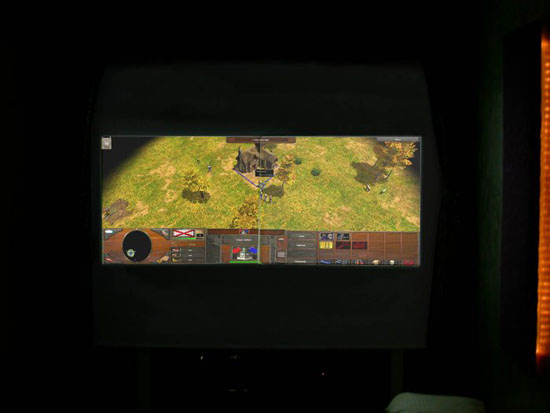
Original Link: https://www.anandtech.com/show/1875
The DualHead2Go: External Multi-Display Upgrade from Matrox.
by Josh Venning on November 25, 2005 6:00 AM EST- Posted in
- Displays
Intro
The name, Matrox, conjures up some memories of older times in computer graphics, and we haven't heard from them in quite a long time. Matrox was a pioneer of PC gaming technology and they were known for the quality of their parts. One of the things that they were first to achieve in PC gaming was support for multiple monitors. They developed dual and triple head support on their graphics parts, and due to its success, other companies at the time also incorporated multi-head support on their hardware as well, making it a standard.
Recently though, Matrox has released a piece of equipment that is made only for running multiple displays as a stand-alone peripheral. While Matrox seems confident that there is a place on the market for a device like this, we have to wonder who might truly benefit from this. Dual monitor support is essentially a standard feature on any desktop graphics card at present, but admittedly, it is lacking for laptops and some older desktop hardware. Matrox's answer to this dilemma is the DualHead2Go, an "External Multi-Display Upgrade for Laptop and PC".

We will look more closely at the DualHead2Go in the next section, and we'll talk a bit more about the hardware and software of this peripheral as well. The suggested retail price of the DualHead2Go is listed at $169, and that seems a little high to us, but before we pass judgment, let’s see what it can actually do.
The DualHead2Go
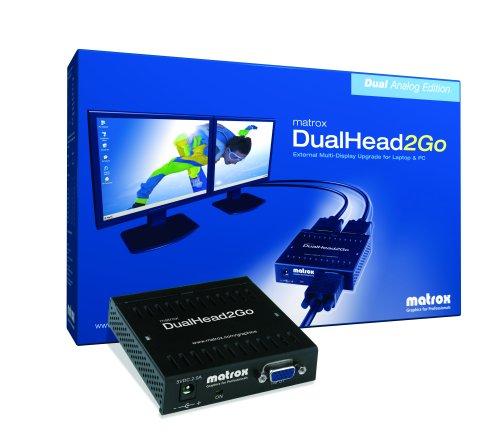
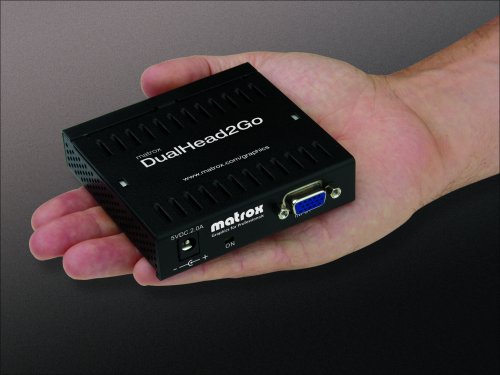
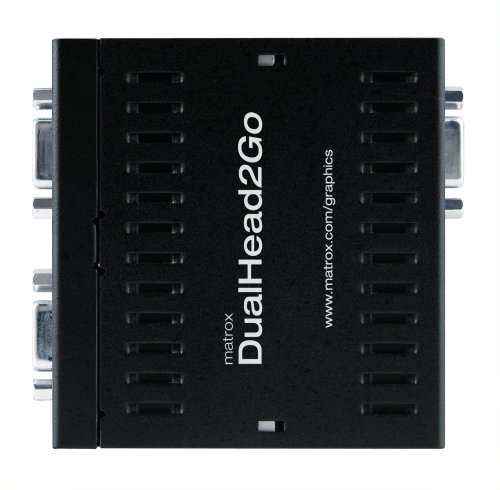
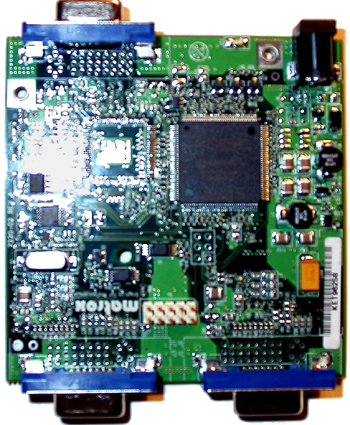
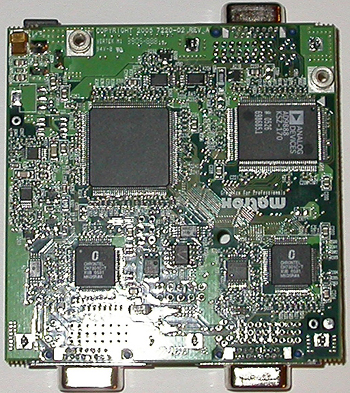
The Cyclone EP1C chips used are what drive the capabilities of the DualHead2Go. As there are no custom Matrox ASICs on the board, we can conclude that the one or both of the FPGAs handle taking the output of the AD9888, splitting the image into two (or clone the image depending on the resolution and PowerDesk settings), and then sending the resulting data along to the Chrontel CH7301C-T display controllers. These devices also likely manage the rest of the board and use the DDC (Display Data Channel) to report the DualHead2Go's EDID (extended display identification data) to the display device.
The CH7301C is a single link DVI transmitter, which supports analog output over three 10-bit DACs for analog RGB displays. This suggests that a digital version of the DualHead2Go wouldn't be that difficult to implement. This part of the design could also be reused if Matrox were to develop a version of the DualHead2Go that supports up to 3200x1200 (or two 1600x1200 displays). Of course, a device such as this would require a dual-link DVI input and a beefier digitizer than the AD9888. The FPGAs may also need an upgrade for a higher resolution version (it would entail more I/O and might require something larger), but the functionality of the device should be easily extendable, so added design time would be minimal.
The DualHead2Go (cont’d)
Matrox refers to the DualHead2Go on the box as an “External Multi-Display Upgrade for Laptop and PC”, and they provide some visual examples of the usage of their device.
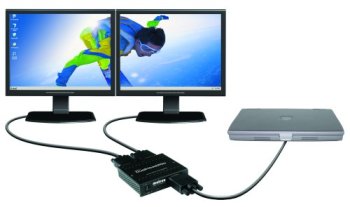
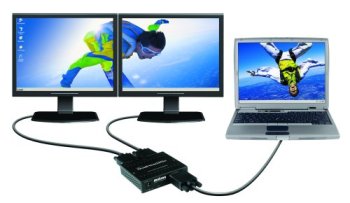
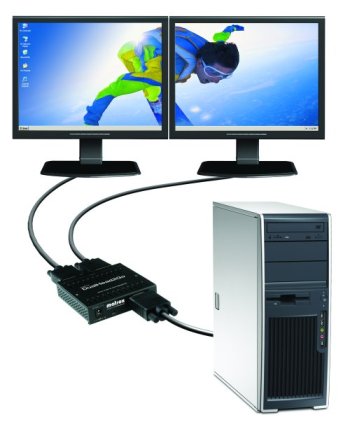
Setting up the drivers and displays to our system was fairly straightforward and we were interested to see how two projection displays would look using the DualHead2Go. These images can give you an idea of what the driver interface looks like.
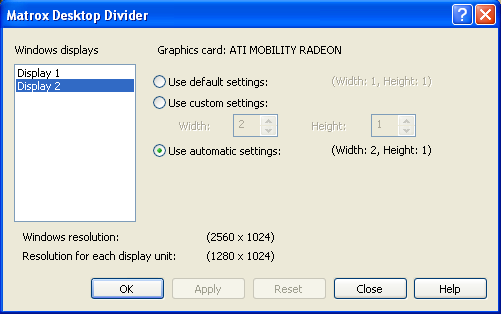
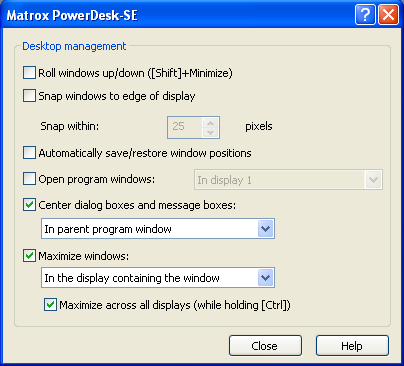
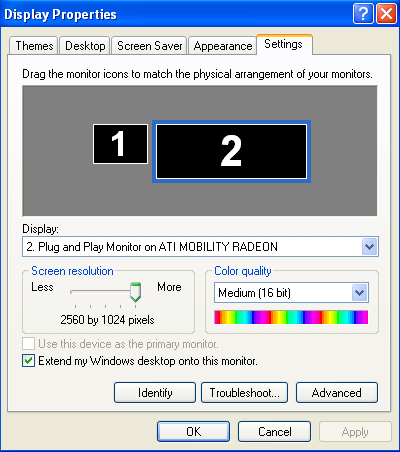
One thing that we would like to see is a dual link DVI version of the DualHead2Go. Because the connections are all analog, the maximum resolution that you can set is limited to 2560X1024 (depending on your system), but with dual link DVI, you could theoretically get much higher. This might be considered extreme, but given that the device is already very specialized, this would only serve to greatly increase its potential for gaming.
Final Words
The DualHead2Go is an interesting concept, but frankly, we can't help but think that it's going to be more or less useless for the average PC user. To its credit, the device does exactly what it claims to do without any problems, and the effect of the dual projection displays with Age of Empires 3 was quite impressive. However, using this for creating an extreme display setup for gaming, regardless of how great the idea sounds, is problematic.
First of all, the $169 (suggested retail) price tag is pretty hefty for something of this type, and chances are, people buying this to have a multi-display setup will also be dropping some extra cash on monitors as well. This alone is a minus, but if you want to use this setup for gaming, two monitors side-by-side won't really cut it. The big problem with having two monitors next to each other is obviously that your monitors will create a break in the middle of the display, and we just don't see this as being acceptable for gaming, especially for types of games like first-person shooters.
We've shown that using two projectors instead of monitors to achieve a seamless wide screen image works very well, and with this setup, the effect is truly stunning. Being able to play your favorite PC game on a 2560X1024 display projected against your wall is a scenario of pure gaming nirvana, and the idea will tantalize anyone. But the reality is that the money necessary to achieve this is extreme, and unless you are filthy rich, you won't be able to even entertain the notion of upgrading to this level. However, if you are able, then you should also be able to afford the dual link DVI version of the DualHead2Go (when/if it comes out), and the pricier projectors to run the higher resolutions that the box should then allow you to do. You would then have attained the holy grail of gaming displays and officially be the envy of all who know you.
Practically though, those who would ultimately benefit most from this device are business people with laptops who require multiple monitors for presentations or extra desktop space for applications. While we can think of a couple of different multi-display setups for this kind of thing, we couldn't imagine that they would be much more useful than a single display setup; at least not enough to warrant the high price of the DualHead2Go peripheral.
The bottom line is that there will be some people who absolutely must have this for business or other reasons, and those people will find the DualHead2Go useful. But for the average laptop owner, the price will probably be too high to justify doing whatever he/she would really like to do with it. And because, as we've said, most current desktop hardware already has support for multiple monitors, desktop users will have even less need for this box. Still, Matrox might be on to something here. For what it is, the DualHead2Go is nice, and certain applications have potential, but most will find this external multi-display upgrade impractical.

